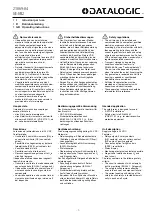
23
INSTALLATION AND OPERATION INSTRUCTIONS — FENCE PROTECTION SYSTEMS
Figure 26. Unreeling Cable
CAUTION:
Extreme care should be used when handling the transducer cable as
nicking or scraping the outer jacket, and kinking or knotting the cable will shorten the
operational life and permit unwanted interference to enter the pre-amp.
The transducer cable should be left with enough length at the pre-amp for a service loop to be used as
a moisture drip leg. See Figure 23. The cable should be attached to the fence in a position 3-6 feet
high. This height is chosen to prevent dogs or small animals from damaging the cable and to prevent
possible damage by grass fires. Sensitivity is best if the transducer is not installed close to horizontal
fence stiffeners.
Cable ties should be located at approximate 12-inch intervals. The transducer cable should be installed
taut enough to prevent movement in the wind, and yet not stretched to a point where excessive strain
will be placed on the cable as the fence is stressed. This can normally be accomplished by pulling the
transducer cable just snug as the plastic cable ties are being installed. See Figure 27.
Typically, a 10-foot high fence requires a single horizontal run of sensor cable. Fences higher than 10
feet require two horizontal runs of cable mounted at 4-5 feet and 8-10 feet.












































